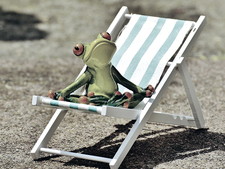-
Topics
subnavigation
Topics
Electromagnetic fields
- What are electromagnetic fields?
- Static and low-frequency fields
- Radiation protection relating to the expansion of the national grid
- High-frequency fields
- Radiation protection in mobile communication
Optical radiation
Ionising radiation
- What is ionising radiation?
- Radioactivity in the environment
- Applications in medicine
- Applications in daily life and in technology
- Effects
- What are the effects of radiation?
- Effects of selected radioactive materials
- Consequences of a radiation accident
- Cancer and leukaemia
- Genetic radiation effects
- Individual radiosensitivity
- Epidemiology of radiation-induced diseases
- Ionising radiation: positive effects?
- Risk estimation and assessment
- Radiation protection
- Nuclear accident management
- Service offers
-
The BfS
subnavigation
The BfS
- About us
- Science and research
- Laws and regulations
- BfS Topics in the Bundestag
- Links
"Don't tell me any summer fairy tales": Fairy tales and tips relating to the protection from UV radiation
Year of issue 2016
Date 2016.07.19
Date 2016.07.19
The UV radiation of the sun is still among those health risks that are strongly underestimated. A number of legends and fairy tales shaping many people's perception are witnesses to that. "How persistent certain images and assumptions are, can be seen from the questions addressed to the BfS every year at the start of the summer holidays regarding the right protection from UV radiation"
, says Ina Stelljes of the Federal Office for Radiation Protection.
Basic knowledge and good protection from UV radiation are important. This is made clear from the number of skin cancer cases caused by UV radiation, which is increasing with every year. In Germany alone, the rate of new cases doubles about every 10 to 15 years – with increasing tendency.
But UV protection is simple – provided one observes some basic rules and is not fooled by a fairy tale:
Fairy tale no. 1: Sunburn is the preliminary stage to golden brown skin
Wrong. Sunburn has got nothing to do with getting a tan. Redness in the skin is an acute damage to the skin which must be avoided. Sunburns, especially during childhood, are proven to be a risk factor for skin cancer. According to most recent studies, the risk increases by up to 80 per cent for people who suffered five or more serious sunburns as youths.
Fairy tale no. 2: The healthy, brown skin
Wrong. "Healthy", brown skin is a myth. A suntan is nothing but a protection mechanism, a response to damages already caused in the skin by the UV radiation. The skin then forms the dark-coloured pigment melanin that arranges around the cell nucleus and protects it.
Already low doses of UV radiation damage the DNA inside the skin cells. If they damage more than can be repaired by the cell repair mechanisms, the DNA damage continues to exist. It is passed on to all daughter cells with the cell division – thus the saying "The skin doesn’t forget anything."
This is how skin cancer develops.
Fairy tale no. 3: As long as I have applied sunscreen, I'm protected from sunburn
Wrong. Basically it is best to avoid UV radiation in the midday sun. It is recommended to stay either inside the house at noon (urgently required from UV index 8) or in the shade (necessary from UV index 3 to 7). On its website at www.bfs.de/uv-prognose, the BfS provides information about the UV index on a daily basis. Apart from this, appropriate clothing and shoes as well as headwear with neck protection and good sunglasses provide protection. Sunscreen is an aid for the skin parts remaining uncovered.
The term of protection of sunscreen depends on the skin type, the sun protection factor and whether sufficient sunscreen has been applied. In the case of high UV intensities, persons with sensitive skin can already get sunburn after about 10 minutes. People choosing sun protection factor 20 have to multiply these 10 minutes with 20, thus getting a rough estimation of the term of protection: in this case 200 minutes, that is about 3 hours. Naturally, the term of protection is adversely affected if people haven't applied enough sunscreen and not reapplied it on a regular basis. As a rule of thumb, an adult needs about 3 to 4 table spoons of sunscreen for the whole body per application.
The BfS recommends using at least sun protection factor 30 for children, 20 for adults. Sunscreen should be reapplied at least every 2 hours. It should also be reapplied after bathing and towelling. But be aware: Reapplication does not extend the protective effect, it only maintains it.
Fairy tale no. 4: Extensive sunbathing is good for your vitamin D balance
It is true that the UV-B radiation of the sun leads to the production of the endogenous vitamin D. This does, however, not require sunbathing over longer periods of time. Moderate stays in the sun are sufficient; this is the unanimous opinion of experts in different disciplines.
In concrete terms that means: For the endogenous vitamin-D balance it is sufficient to expose face, hands and arms uncovered and without sun protection to the sun two to three times a week and for only half of the time one would otherwise get a sunburn without protection. The latter is always to be considered individually, depending on skin type and skin thickness.
Fairy tale no. 5: People using sunscreen with a high sun protection factor don't get a tan
Wrong. The skin also gets a tan with sunscreen applied, but it takes longer, and this is no disadvantage: That way, the skin can get better used to UV radiation.
More information at www.bfs.de/uv
State of 2016.07.19




